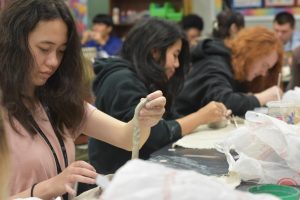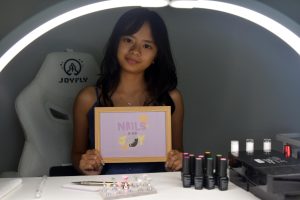Finding myself through music
Kathleen Ortiz found comfort in Selena Quintanilla-Pérez’s music when she struggled with her own identity of fitting in.
January 12, 2021
I combed my fingers through my hair as my sisters and I walked down the steps of the church. We made it into the basement and waited anxiously for the nuns to tell us where to go for Sunday school. My youngest sister tried to make jokes to forget the nerves, but it didn’t work too well. We had just moved to St. Louis, Missouri, and after spending our entire lives at our old church back in Texas we weren’t sure how easy it would be to make friends at this new one.
After my sisters were dropped off at classrooms throughout the building, the nun directed me past the cafeteria to a large meeting room in the very back. I could still smell the donuts in the cafeteria as I walked through the glass doors and was introduced to my Sunday school teacher.
As I was introduced, I surveyed the room. There were five circular tables: three were filled with boys and two with girls. I quickly decided to sit at one of the girls’ tables, but it took longer to decide which one. Six white girls sat at one table, and five Latinas sat at another. My dad is Mexican-American and my mom is Anglo-American. Growing up in Texas I had a variety of friends who were white and a variety of friends who were Latino. I had never before been posed with a situation where I had to choose between the two groups.
That first day I ended up sitting with the white girls. However, the next week I sat with the Latinas. I kept going back and forth, never quite feeling as if I had made a connection with either group.
Each week I would go down to that meeting room and hope that maybe for once someone would say something that I could relate to. I was confused. How could I feel so isolated when I felt that I should fit in with both groups?
Later that year, the answer I was looking for showed up through a new artist I had never paid much attention to. My sister became obsessed with the “Queen of Tejano Music” Selena Quintanilla. She listened to “Como La Flor” and “Bidi Bidi Bom Bom” everywhere she went. Soon enough, I caught the Selena bug. Her music was beautiful, and I felt seen by her story.
We’re both Latinas from Texas who grew up with a love for performing. She couldn’t speak Spanish, and while I am fluent, I get extremely nervous when I speak it. What stood out the most to me, however, was a quote from her movie. “We have to be more Mexican than the Mexicans and more American than the Americans, both at the same time,” her dad said. “It’s exhausting.” That quote described my situation perfectly.
There I was trying my very best to be more Latina than the Latinas one week and then whiter than the white girls the next. I was exhausted, but Selena could relate. Her music became an escape for me during the weekdays while I mentally prepared myself for Sunday school that weekend.
Listening to her songs, watching her movie, and listening to her interviews helped me with my own identity. Someone just like me was out there, and her music was celebrated all over the world.









Gina Sanchez • Jan 13, 2021 at 10:11 am
This is an amazing piece!!. And yes …. I feel like you everyday!! We got this!